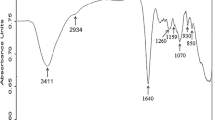Abstract
Studies carried out to breakdown the yield and Fourier-Transform Infrared (FTIR) spectral properties of polysaccharide from Corallina elongata (J.Ellis & Solander), Liagora mannarensis (V.Krishnamurthy & Sundararajan) and Portieria hornemannii (Lyngbye). Carrageenan yield in the range of 16.4 to 24.2% in fresh algae than 14.2 to 23.8% defatted algae was recorded. Spent biomass in the range of 62.0 to 72.0% in fresh algae than 61.2–70.4% defatted algae was recorded. Total sugar, reducing sugar and sulphate were maximum in P. hornemannii (Lyngbye) and minimum in C. elongata (J.Ellis & Solander) having fresh algae carrageenan compared to the defatted algae carrageenan. FTIR spectroscopy study shows that the carrageenan extracted from fresh and defatted C. elongata (J.Ellis & Solander) have both kappa and iota type carrageenan. Fresh and defatted carrageenan from L. mannarensis (V.Krishnamurthy & Sundararajan) and P. hornemannii (Lyngbye) have kappa, lamda and iota type carrageenan.







Similar content being viewed by others
References
Chopin T, Whalen E (1993) A new and rapid method for carrageenan identification by Ftir diffuse-reflectance spectroscopy directly on dried ground algal material. Carbohydr Res 246:51–59
Chopin T, Hanisak MD, Kohen FE, Million J, Moreau S (1990) Studies on carrageenan and effects of seawater phosphorus concentration on carrageenan content and growth of Agardhiella subulata (C.Agardh) Kraft and Wynne (Rhodophyceae, Solieriaceae). J ApplPhycol 2:3–16
Correa-Dı´az F, Aguilar-Rosas R, Aguilar-Rosas LE (1990) Infrared analysis of eleven carrageenophytes from Baja California Mexico. Hydrobiologia 204(205):609–614
Craigie JS (1990) Cell walls. In: Cole KM, Sheath RG (eds) Biology of the red algae. Cambridge University Press, Cambridge, pp 221–258
Craigie JS, Leigh C (1978) Carrageenan and agar. In: Hellebust JA, Craigie JA (eds) Handbook of physiological methods: physiological and biochemical methods. Cambridge University Press, Cambridge, pp 109–131
Dubois M, Gilles KA, Gilles JK, Hamilton PA, Rebers F, Smith (1956) Colorimetric method for determination of sugars and related, substances. Anal Chem 28:350–356
Estevez J, Ciancia M, Cerezo A (2004) The system of galactans of the red seaweed, Kappaphycus alvarezii, with emphasis on its minor constituents. Carbohydr Res 339:2575–2592
Freile-Pelegrin Y, Robledo D (2006) Carrageenan of Eucheuma isiforme (Solieriaceae, Rhodophyta) from Yucatán, Mexico. II. Seasonal variations in carrageenan and biochemical characteristics. Bot Mar 49:72–78
Imeson AP (2000) Carrageenan. In: Phillips GO, Williams PA (eds) Handbook of hydrocolloids, CRC Press, Boca Raton
Krishnapillai V (1957) Chemical studies on Indian seaweeds. Proc Indian Acad Sci 3:1–22
Lewis JG, Stanley NF, Guist GG (1988) Commercial production and application of algal hydrocolloides. In: Lembi CA, Robertwalland J (eds) Algae and human affairs. Cambridge University Press, Cambridge, pp 205–236
Nelson WR, Van Staden J (1984) The effect of seaweed concentrates on the growth of nutrient-stressed, greenhouse cucumbers. J Horti Sci 19:81–82
Palanivelu A, Padmanaban R, Sivakumar SR, Arunkumar K (2008) Yield and quality of agar and carrageenan from some red seaweed on varied substrata along Thondi coast (Palk Bay) Tamil Nadu. Seaweed Res Util 30(1&2):109–118
Pelegrin P (2011) Many ways to dilate the P2X7 receptor pore. Br J Pharmacol 163:908–911
Pereira L, Mesquita JF (2003) Carrageenophytes of occidental Portuguese coast: 1-spectroscopic analysis in eight carrageenophytes from Buarcos bay. Biomol Eng 20(4–6):217–222
Pereira L, Sousa A, Coelho H, Amado AM, Ribeiro-Claro PJA (2003) Use of FTIR, FT-Raman and 13C-NMR spectroscopy for identification of some seaweed phycocolloids. Biomol Eng 20(4–6):223–228
Rajasulochana N, Baluswami M, Vijayaparthasarathy MD, Krishnamurthy V (2008) FT-IR spectroscopic investigations on the agars from Centroceras clarulatum and Spyridia hypnoides. Int J Phycol Phycochem 4(2):125–130
Rees DA (1969) Structure, conformation and mechanism in the formation of polysaccharide gels and networks. Adv Carbohydr Chem Biochem 24:267–332
Roberts MA, Quemener B (1999) Measurement of carrageenans in food: challenges, progress, and trends in analysis. Trends Food Sci Technol 10:169–181
Rochas C, Lahaye M, Yaphe W (1986a) Sulfate content of carrageenan and agar determined by infrared spctroscopy. Bot Mar 29(10):33
Rochas C, Lahaye M, Phan YM, Vict MT (1986b) I3C NMR-spcctroscopic investigation of agarose oligomers. Carbohydr Res 1(48):199–207
Schaffelke B, Hewitt CL (2007) Impacts of introduced seaweeds. Bot Mar 50:397–417
Schaffelke B, Smith JE, Hewitt CL (2006) Introduced macroalgae: a growing concern. J Appl Phycol 18:529–541
Stancioff DJ, Stanley NF (1969) Infrared and chemical studies of algal polysaccharides. Proc Int Seaweed Symp 6:595–609
Usov A (2011) Polysaccharides of the red algae. Adv Carbohydr Chem Biochem 65:115–217. https://doi.org/10.1016/B978-0-12-385520-6.00004-2
van de Velde F, de Ruiter GA (2002) Carrageenan. In: Vandamme EJ, SD Baets, Steinbèuchel A (eds). Polysaccharides II, polysaccharides from eukaryotes. Wiley-VCH, Weinheim, Chichester, Biopolymers v. 6: 245–274
Williams SL, Smith JE (2007) A global review of the distribution, taxonomy, and impacts of introduced seaweeds. Annu Rev Ecol Evol Syst 38:327–359
Author information
Authors and Affiliations
Corresponding author
Additional information
Publisher's Note
Springer Nature remains neutral with regard to jurisdictional claims in published maps and institutional affiliations.
Rights and permissions
About this article
Cite this article
Chidambaram, P., Jeyprakash, A. & Chinnathambi, P. Characterisation of carrageenan extracted from fresh and defatted red algae along the Pamban coast, Tamilnadu, India. Vegetos 32, 281–287 (2019). https://doi.org/10.1007/s42535-019-00045-0
Received:
Revised:
Accepted:
Published:
Issue Date:
DOI: https://doi.org/10.1007/s42535-019-00045-0




